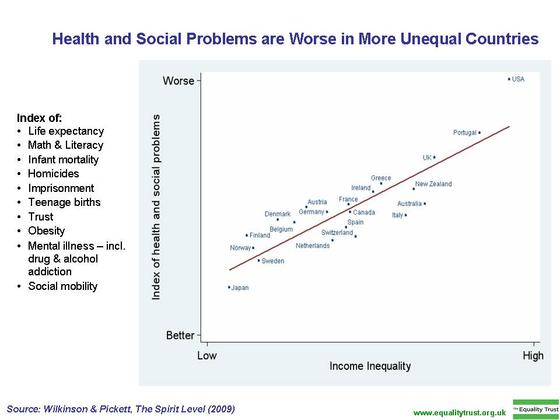
The Spirit Level
Jean Sammon
June 30, 2011
Many of us at NETWORK were intrigued by The Spirit Level – Why Greater Equality Makes Societies Stronger, the book that shows why a less-equal society is bad for everyone.
The authors – Professors Richard Wilkinson and Kate Pickett – did extensive research on various social problems in developed nations and found a correlation between a nation’s income inequality and social problems. The chart above shows that correlation.
Note that the U.S. has the highest level of income inequality of all the other developed nations, and also the highest level of social problems.
(The book has charts showing the correlation for each of the social problems listed. You can also find them at: www.equalitytrust.org.uk/resources/other/TSL-slides)
A Matter of Trust
What surprised me the most was that “trust” was included as a social problem. But after reading the chapter on trust I now understand why the level of trust is a problem. Here’s what I found:
“Changes in inequality and trust go together over the years. With greater inequality, people are less caring of one another, there is less mutuality in relationships, people have to fend for themselves and get what they can – so, inevitably there is less trust. Mistrust and inequality reinforce each other. . . . we are less likely to empathize with those not seen as equals; material differences serve to divide us socially.” (p.56)
How is the level of trust measured?
For the U.S. it’s the National Opinion Research Center’s General Social Survey question that asks people whether or not they agree that most people can be trusted. In 1960, 60 percent of respondents agreed. By 2004, this had fallen to 40%.
This isn’t good. Because when people don’t trust each other they don’t cooperate with each other. This erodes ‘social capital’ which is a term used to describe people’s involvement in community life.
Political scientist Robert Putnam says that “. . . citizens in high social capital states [are] likely to do more to reduce inequalities, and inequalities themselves [are] likely to be socially divisive.” (p. 55)
The authors of The Spirit Level believe that “inequality increases the social distance between different groups of people, making us less willing to see them as ‘us’ rather than ‘them’”. (p. 62)
All this sounds believable to me.
The other chapters in the book discuss the other social problems listed above. But I think the heart of the book, and perhaps the reason the book is titled The Spirit Level, is the chapter about trust, which is titled “Community life and social relations.”
What kind of community life and social relations do we envision for our country? Can we achieve it with such a high level of wealth and income inequality, and such a low level of trust?
Click here to return to main Blog page
Click here to check out, learn more, and join the Mind the Gap! campaign






